About drives and their use on modern computers
An integral part of the life of almost any lover of retro computers are floppy disks floppy disks and floppy drivesdisk drives. What brings its problems today. If working disks can still be found in sufficient quantities, then everything is bad with floppy disks. Almost not on sale, and what can be found - in quality below the plinth. Last year, I found three boxes in one store - with difficulty I scored a dozen work diskettes that survived two formats. And old floppy disks, although they were more reliable, also have their own lifespan. This is the first problem.
The second problem is that even if you have a sufficient supply of floppy disks, then modern computers no longer have the ability to connect drives, so if necessary, copying something to a retro computer turns into a problem with different solutions.
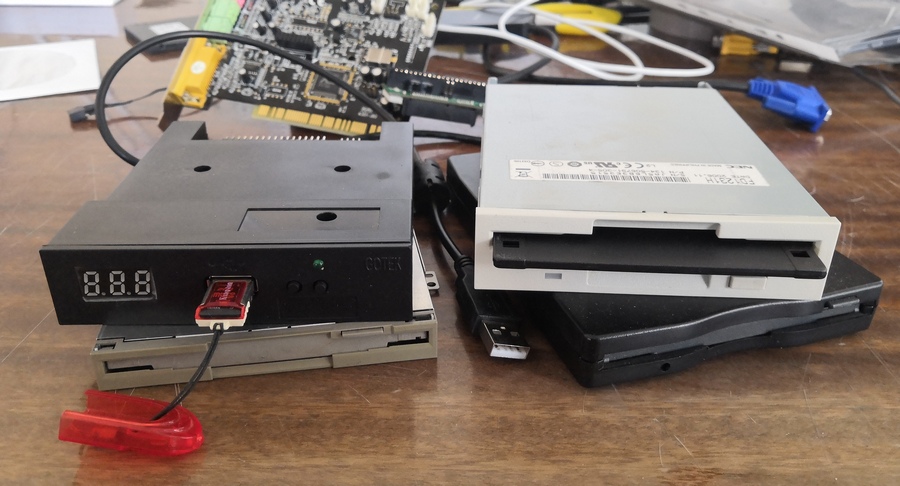
Here I want to write about the options, from hardcore and expensive to casual and not very expensive.
I will start, perhaps, with a different hardcore - for those who need 100% authenticity of the media and for those who are busy with equipment other than PC - there are all kinds of commodors, amigos and other spectra where the format of diskettes may differ from the standards accepted in the x86 world .
A bit from the history of the issue - somewhere in the middle of the zero there was a multicard on PCI, where, among other things, there were drive controllers. It was called Catweasel Mk4 .
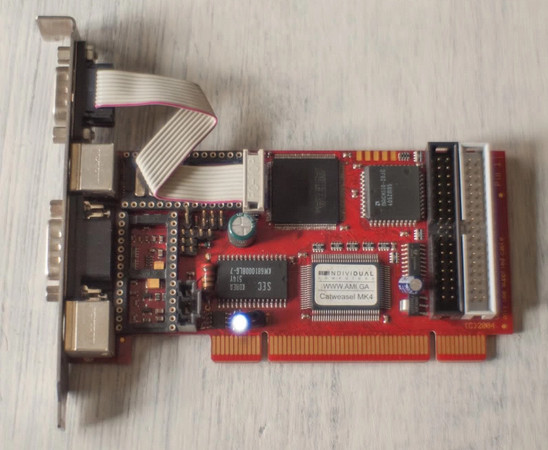
But it’s already gone down in history, it’s not being made, it’s almost impossible to find even at flea markets, and even if you find it, they will break money for it immeasurably. Somewhere I met a message from a person who was ready to buy for about $ 400, but no one was eager to sell him. On ebay, the last auction ended at 250 euros, before it - something about 380 euros (this is MK4, older versions were also sold there, but not really cheaper). Therefore, the device is of interest to collectors of rare iron rather than to those who will use it for its intended purpose.
FC5025 USB 5.25 "floppy controller is also a thing of theoretical rather than practical interest. A
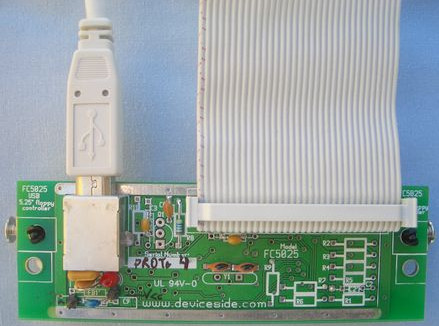
board for connecting five-inch drives via USB. It worked strictly with 5.25" drives, it worked strictly for reading. In general, the thing is not too functional and almost gone in history. At least I have not heard anyone use it today. Although the manufacturer’s website still offers to buy for $ 55.
Well, the current omnipotent favorite is KryoFlux .
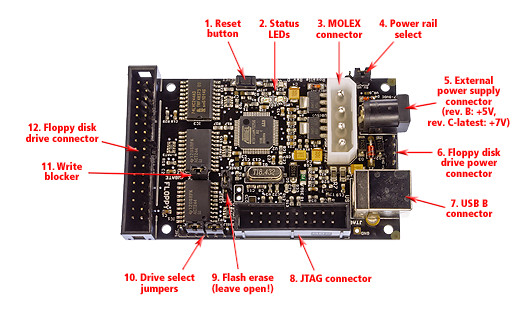
This is a USB adapter for connecting drives. It can work with almost any drive, from 3 "to 8", read and write almost any disk format in a bunch of modes ... In general, what can I describe here, it’s better to give the developers a word: Commercial:
But this is exactly the tool for working with diskettes that is obtained, and not a full-fledged drive - it works only with disk images in different formats. Just copying a couple of files to a floppy disk will not work. But if you need to make an image of some old floppy disk - that’s it. As far as I know, if you enable the most detailed reading, that a RAW image of a 360 kilobyte diskette will take you about 60 megabytes. This device costs 100 euros, not very cheap, but not that much, too, if retro computers are a serious hobby.
SuperCard Pro is a slightly less well-known analogue of KryoFlux. It works on the same principle, costs about the same money.
It is more focused on reading and writing copy-protected discs, while KryoFlux is more positioned for archiving old software.
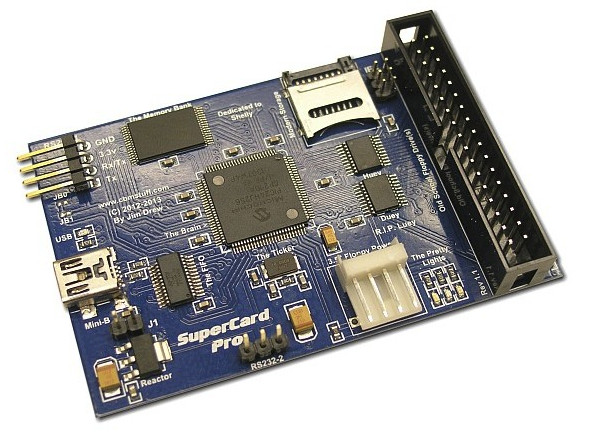
If the above solutions were for those who seriously dedicated their lives to retrocomputing, then I will list the options for those who do not want to spend a lot of time and money, but simply want to copy a couple of files to an old computer. But he does not want to spend a hundred euros and each time create an image of a floppy disk, a more casual solution is preferable.
Well, what can I say ... You can, of course. Take from somewhere "from the middle" a computer that will be small in size, normally support a local network and at the same time have a drive. For example, a laptop of some time from the third pentiums. But here the problem will be that an additional rather heavy link appears - each time it’s very lazy to open a barrel organ to drop a couple of files onto a floppy disk, I know by myself.
Because the first thing that comes to mind for working with floppy disks on modern computers is a regular USB-drive.

It is inexpensive even a new one, it is sold everywhere, it is elementary in use. Most of it is enough.
There are two problems. First, such drives are limited to 1.44 floppy disks, a controller limitation. But you can close your eyes to this, 95% of PCs have disk drives that normally understand this format of diskettes. The second problem is worse - you are still attached to physical disks that are mortal. Often - quickly and suddenly mortal.
This is a variant of the previous solution - as a result, you get the same USB-drive, only on the basis of your favorite floppy.
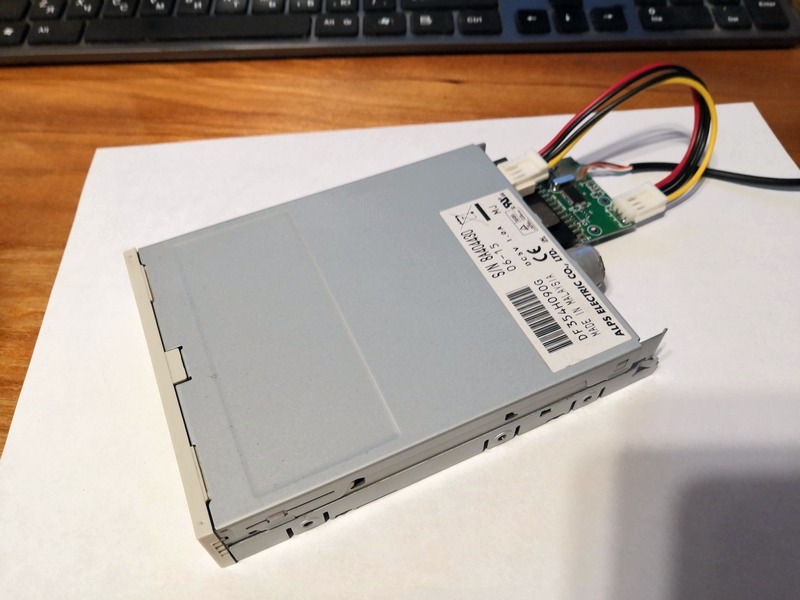
I somehow didn’t think about it at all, but one familiar synthesizer owner had the urge to put exactly her favorite drive in my new i7, I didn’t agree to a replacement. As it turned out, such an opportunity exists , and not so expensive. Although not very popular, and more expensive than a simple USB-drive. Advantage - you can use your favorite drive, you can put it inside the case, and not keep it outside. The disadvantages are the same as in the previous version - the controller is used the same.
And finally, perhaps, they came to the most correct solution for those who want convenience and not authenticity - a drive emulator that allows you to get rid of physical diskettes by replacing them with a flash drive.
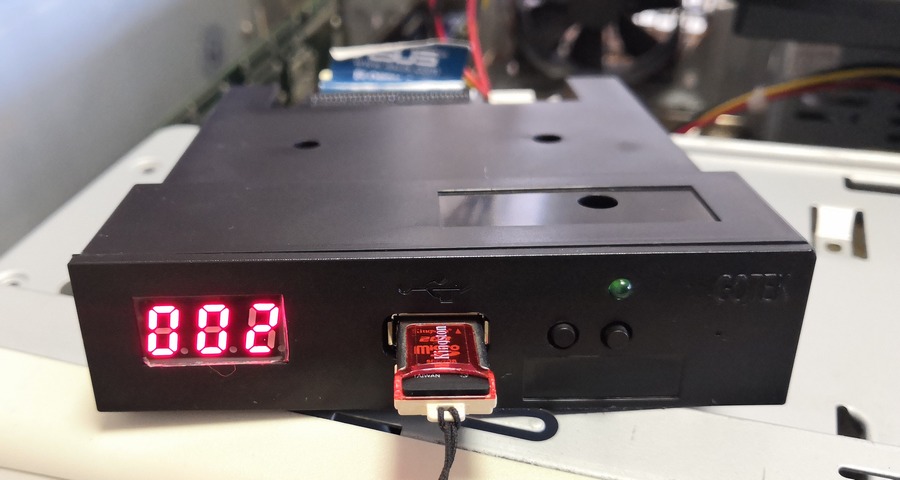

The principle of use - the emulator is installed on your retro computer instead of the drive - connecting to the FDD controller, and disk images are written to the flash drive. Use the buttons to switch the image number (one unit button, the second tens, both together hundreds). Theoretically, it is possible to set numbers from 0 to 999, but the software limit is up to 99. Although it is normal.
The program interface for working with images on a flash drive. The flash drive itself does not have a file system, it is formatted specifically for use in the emulator. In fact, it is just sequential “dumps” of floppy disks, and with the buttons on the emulator you simply set the offset — the basic firmware is very simple.
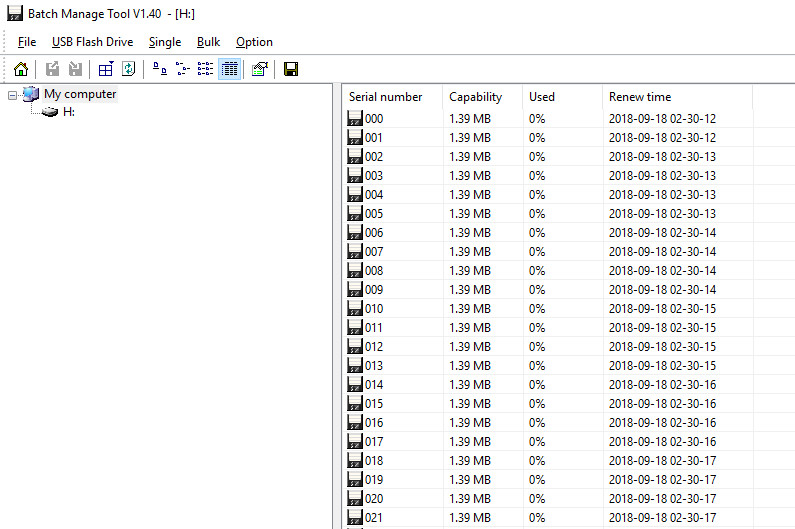
When you connect it directly to a computer, it is visible as a 1.44 megabytes USB drive and, in principle, you can work directly with your “big brother” with this “image” by copying files there.

With other "diskettes" work only through the program. You can either write the image to a specific place or “Open the diskette” in Windows Explorer - then the files from there will be copied to a temporary folder on the hard drive, you can add or delete something there, and then give a command to write back. But at the same time, the boot sector deteriorates, therefore it is better not to touch boot disks.
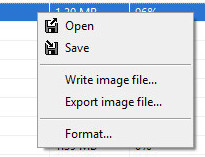
Then simply insert the USB flash drive into your retro computer, select the desired “diskette” and work as with a regular drive. Here it is already possible to safely format, copy and delete files directly, while nothing spoils. The speed of operation is slightly higher than the hardware drive, the device does not make sounds.
Advantages - get away from physical diskettes, which greatly simplifies life. And not only lovers of retro computers. Similar emulators are used in industrial equipment and musical synthesizers, where it is easier to change the device for downloading files than to change the equipment itself to a more modern one.
Disadvantages - the base and cheapest emulator only works with 1.44 diskettes. Other options (1.2, 720k) are sold, but cost more.
To combat the flaw, there are alternative firmware. I found FlashFloppy interesting . Free, open source, supports a bunch of image and disk formats.
I myself haven’t reached it yet - there’s simply no need, wherever such emulators were installed, ordinary 1.44 disk drives were used.
It is also possible to modify the emulator in hardware - change the screen, add a speaker, add a pen to quickly switch images ...
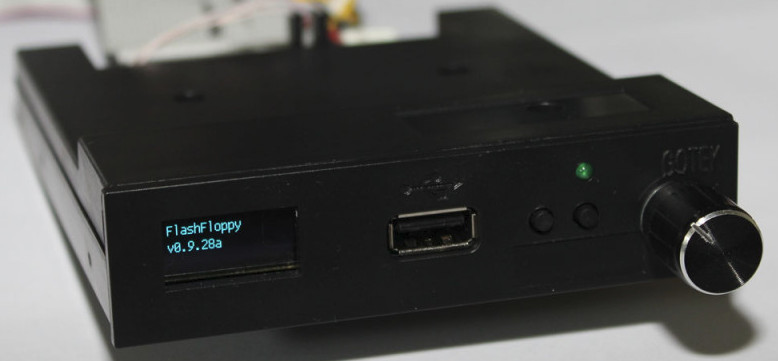
Well, I bought myself emulators, but now where to put the old drives, do not throw it away?
Why throw it away? You can make a musical instrument out of them, for example.
Good video review of KryoFlux from the point of view of the user .
A more detailed overview of the drive emulator .
A more detailed overview of the adapter for connecting a drive .
The topic on the forum is dedicated to the firmware of the emulator .
Drive Music Playlist .
The second problem is that even if you have a sufficient supply of floppy disks, then modern computers no longer have the ability to connect drives, so if necessary, copying something to a retro computer turns into a problem with different solutions.

Here I want to write about the options, from hardcore and expensive to casual and not very expensive.
Hardcore mode on
I will start, perhaps, with a different hardcore - for those who need 100% authenticity of the media and for those who are busy with equipment other than PC - there are all kinds of commodors, amigos and other spectra where the format of diskettes may differ from the standards accepted in the x86 world .
Catweasel
A bit from the history of the issue - somewhere in the middle of the zero there was a multicard on PCI, where, among other things, there were drive controllers. It was called Catweasel Mk4 .

But it’s already gone down in history, it’s not being made, it’s almost impossible to find even at flea markets, and even if you find it, they will break money for it immeasurably. Somewhere I met a message from a person who was ready to buy for about $ 400, but no one was eager to sell him. On ebay, the last auction ended at 250 euros, before it - something about 380 euros (this is MK4, older versions were also sold there, but not really cheaper). Therefore, the device is of interest to collectors of rare iron rather than to those who will use it for its intended purpose.
FC5025
FC5025 USB 5.25 "floppy controller is also a thing of theoretical rather than practical interest. A

board for connecting five-inch drives via USB. It worked strictly with 5.25" drives, it worked strictly for reading. In general, the thing is not too functional and almost gone in history. At least I have not heard anyone use it today. Although the manufacturer’s website still offers to buy for $ 55.
Kryofllux
Well, the current omnipotent favorite is KryoFlux .

This is a USB adapter for connecting drives. It can work with almost any drive, from 3 "to 8", read and write almost any disk format in a bunch of modes ... In general, what can I describe here, it’s better to give the developers a word: Commercial:
Read at lowest level possible - precisely sampling the magnetic flux transition timing. Custom formats? Recording scheme violations? Encodings? KryoFlux reads them all!
Save as raw stream, or export to common sector formats supporting: Acorn Electron, Apple, Amstrad CPC, Archimedes, Atari 8-bit, Atari ST, BBC, Commodore 64, Commodore Amiga, MSX, IBM PC, PC-8801, Sam Coupe, Spectrum, E-MU Emulator & Emulator II, DEC RX01 & RX02 and many, many others.
Write back to disk. KryoFlux not only creates direct clones based on raw (STREAM) data dumped, but also supports fully verified "one-click" writing of ADF, G64 and IPF files, with more formats in development.
Need to duplicate an alien disk? With our patent-pending RepliFlux technology, KryoFlux will create bit-identical copies of almost any disk.
Load raw dumps instantly in the emulator of your choice, e.g., but not limited to: WinUAE, FS-UAE, E-UAE, WinSTon, Hatari, STEem, Caprice and Spectaculator.
Parallel export support. E.g. An Amiga/ST dual format disk can be written as raw stream, an ADF and an ST file, all at the same time during a single disk capture.
Intelligent software allows production of sector images for virtually all normal disks for systems containing a generic FM or MFM floppy controller. Many other weird synthesiser sample disk formats should work right out of the box.
Reading and writing is completely independent of real drive speed, also supports variable rate "zoned CAV" disks (e.g. Apple) in a normal fixed rate drive.
Software completely free for private, non-commercial use.
Easy to use graphical user interface.
RoHS compliant and WEEE registered.
High quality immersion gold coated boards, made to last a lifetime.
The de-facto standard for true disk imaging and preservation.
But this is exactly the tool for working with diskettes that is obtained, and not a full-fledged drive - it works only with disk images in different formats. Just copying a couple of files to a floppy disk will not work. But if you need to make an image of some old floppy disk - that’s it. As far as I know, if you enable the most detailed reading, that a RAW image of a 360 kilobyte diskette will take you about 60 megabytes. This device costs 100 euros, not very cheap, but not that much, too, if retro computers are a serious hobby.
Supercard pro
SuperCard Pro is a slightly less well-known analogue of KryoFlux. It works on the same principle, costs about the same money.
It is more focused on reading and writing copy-protected discs, while KryoFlux is more positioned for archiving old software.

Hardcore mode off
If the above solutions were for those who seriously dedicated their lives to retrocomputing, then I will list the options for those who do not want to spend a lot of time and money, but simply want to copy a couple of files to an old computer. But he does not want to spend a hundred euros and each time create an image of a floppy disk, a more casual solution is preferable.
A separate computer for recording floppy disks
Well, what can I say ... You can, of course. Take from somewhere "from the middle" a computer that will be small in size, normally support a local network and at the same time have a drive. For example, a laptop of some time from the third pentiums. But here the problem will be that an additional rather heavy link appears - each time it’s very lazy to open a barrel organ to drop a couple of files onto a floppy disk, I know by myself.
USB drive
Because the first thing that comes to mind for working with floppy disks on modern computers is a regular USB-drive.

It is inexpensive even a new one, it is sold everywhere, it is elementary in use. Most of it is enough.
There are two problems. First, such drives are limited to 1.44 floppy disks, a controller limitation. But you can close your eyes to this, 95% of PCs have disk drives that normally understand this format of diskettes. The second problem is worse - you are still attached to physical disks that are mortal. Often - quickly and suddenly mortal.
Adapter for connecting a standard drive via USB
This is a variant of the previous solution - as a result, you get the same USB-drive, only on the basis of your favorite floppy.

I somehow didn’t think about it at all, but one familiar synthesizer owner had the urge to put exactly her favorite drive in my new i7, I didn’t agree to a replacement. As it turned out, such an opportunity exists , and not so expensive. Although not very popular, and more expensive than a simple USB-drive. Advantage - you can use your favorite drive, you can put it inside the case, and not keep it outside. The disadvantages are the same as in the previous version - the controller is used the same.
3.5 "drive emulator
And finally, perhaps, they came to the most correct solution for those who want convenience and not authenticity - a drive emulator that allows you to get rid of physical diskettes by replacing them with a flash drive.


The principle of use - the emulator is installed on your retro computer instead of the drive - connecting to the FDD controller, and disk images are written to the flash drive. Use the buttons to switch the image number (one unit button, the second tens, both together hundreds). Theoretically, it is possible to set numbers from 0 to 999, but the software limit is up to 99. Although it is normal.
The program interface for working with images on a flash drive. The flash drive itself does not have a file system, it is formatted specifically for use in the emulator. In fact, it is just sequential “dumps” of floppy disks, and with the buttons on the emulator you simply set the offset — the basic firmware is very simple.

When you connect it directly to a computer, it is visible as a 1.44 megabytes USB drive and, in principle, you can work directly with your “big brother” with this “image” by copying files there.

With other "diskettes" work only through the program. You can either write the image to a specific place or “Open the diskette” in Windows Explorer - then the files from there will be copied to a temporary folder on the hard drive, you can add or delete something there, and then give a command to write back. But at the same time, the boot sector deteriorates, therefore it is better not to touch boot disks.

Then simply insert the USB flash drive into your retro computer, select the desired “diskette” and work as with a regular drive. Here it is already possible to safely format, copy and delete files directly, while nothing spoils. The speed of operation is slightly higher than the hardware drive, the device does not make sounds.
Advantages - get away from physical diskettes, which greatly simplifies life. And not only lovers of retro computers. Similar emulators are used in industrial equipment and musical synthesizers, where it is easier to change the device for downloading files than to change the equipment itself to a more modern one.
Disadvantages - the base and cheapest emulator only works with 1.44 diskettes. Other options (1.2, 720k) are sold, but cost more.
To combat the flaw, there are alternative firmware. I found FlashFloppy interesting . Free, open source, supports a bunch of image and disk formats.
ADF (Commodore Amiga)
ADM, ADL, ADF, DSD, SSD (Acorn DFS and ADFS)
D81 (Commodore 64 1581)
DSK (Amstrad CPC, Spectrum +3, Sam Coupe, Microbee)
FDI, HDM (NEC PC-98)
IMG, IMA, DSK (IBM MFM Raw Sector)
JVC, DSK (Tandy Color Computer 'CoCo')
MBD (Spectrum MB02)
MGT (Spectrum DISCiPLE/+D)
OPD (Spectrum Opus Discovery)
SDU (SAB Diskette Utility)
ST (Atari ST)
TRD (Spectrum TR-DOS)
V9T9, DSK (TI-99/4A)
VDK (Dragon)
HFE, HFEv3 (Universal)
I myself haven’t reached it yet - there’s simply no need, wherever such emulators were installed, ordinary 1.44 disk drives were used.
It is also possible to modify the emulator in hardware - change the screen, add a speaker, add a pen to quickly switch images ...

What to do with old drives
Well, I bought myself emulators, but now where to put the old drives, do not throw it away?
Why throw it away? You can make a musical instrument out of them, for example.
Related Links
Good video review of KryoFlux from the point of view of the user .
A more detailed overview of the drive emulator .
A more detailed overview of the adapter for connecting a drive .
The topic on the forum is dedicated to the firmware of the emulator .
Drive Music Playlist .
